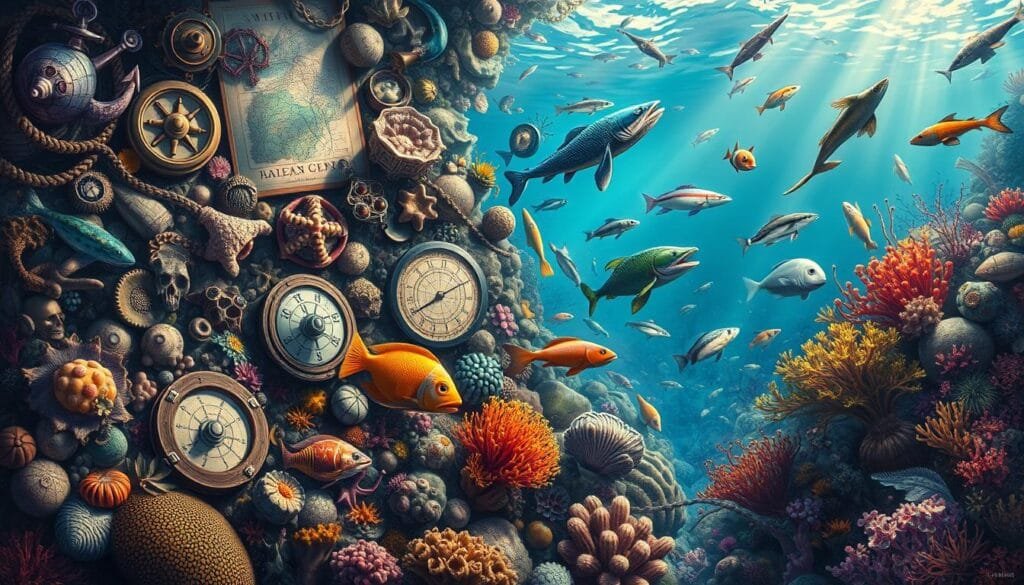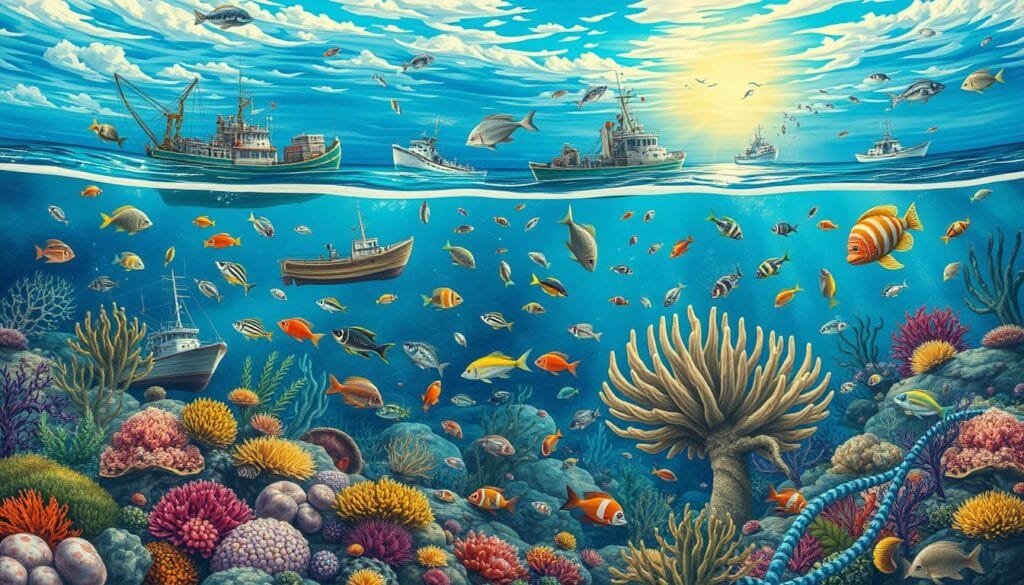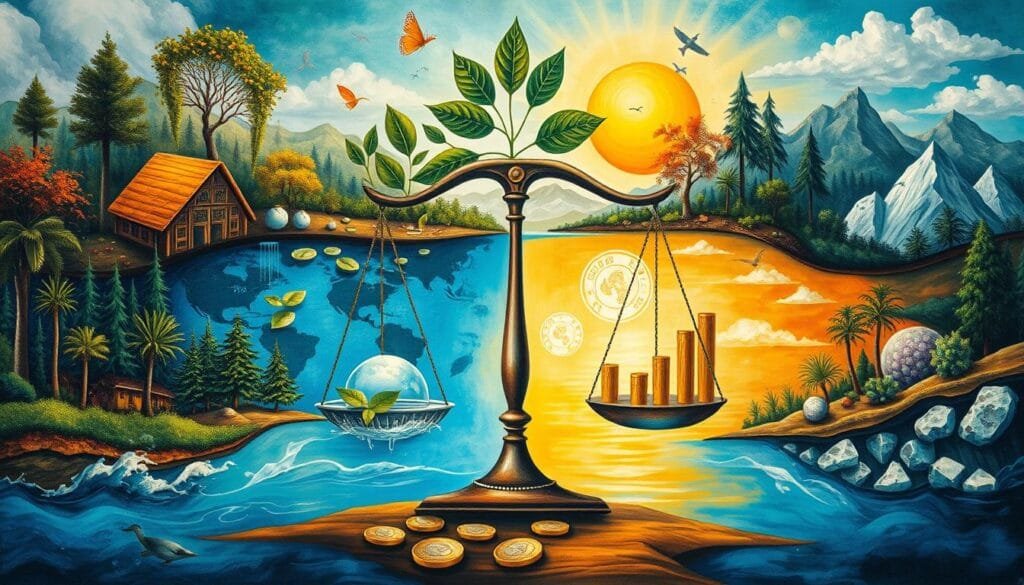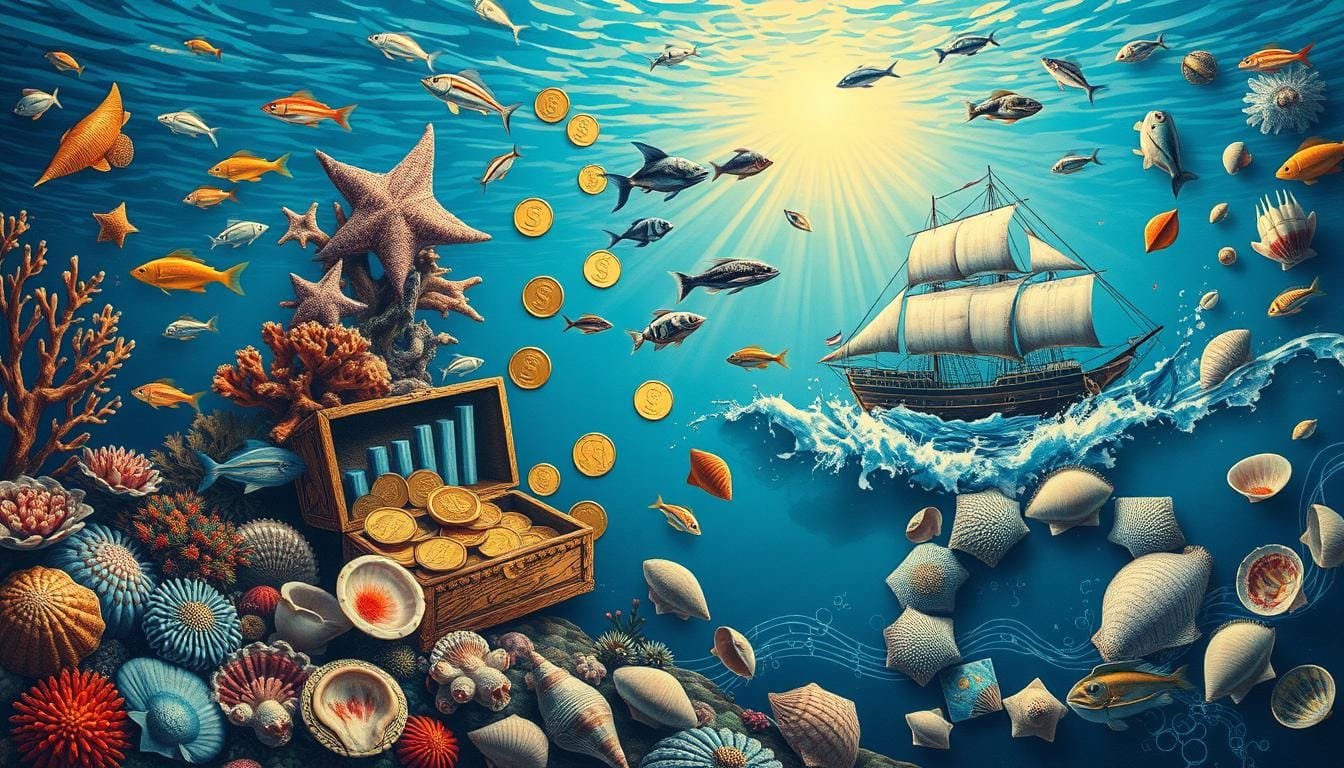Have you ever thought about how our oceans affect the world’s economy? Maritime trade and ocean commerce are big parts of it. These parts have special ideas that are key for anyone wanting to learn sea economics.
The language of the sea covers everything from small community impacts to big international policies. Knowing this language helps to understand ocean trade’s role in the world economy and its sustainability.
We’re here to walk you through sea economics’ basic ideas and words. As we explore maritime trade terms and economic indicators, you’ll learn a lot. For a broader understanding, make sure to check out this guide to economic terminology.
Key Takeaways
- Sea economics includes both small-scale and large-scale economic views.
- Learning the vocabulary is crucial to fully understand maritime economics.
- #Sea economics terms# are important for global trade and keeping economies sustainable.
- More than 30% of people worldwide depend on the oceans for their jobs.
- The oceans play a vital role in feeding people and improving the economy.
Introduction to Sea Economics
Learning sea economics is key to understanding global trade. An introduction to maritime economy highlights the importance of sea trade routes. They tie nations and economies together worldwide. Goods and resources travel through these routes, critical to world commerce.
ENOW data gives yearly economic facts for six marine sectors. It spans from national to county levels. This data shows the ocean’s impact on economies. In coastal areas, it includes jobs, businesses, wages, and GDP data, showing the sector’s significance.
The Marine Economy Account shows stats for ten ocean and Great Lakes sectors. These align with the Bureau of Economic Analysis’s reports. It shows how the ocean supports our economy. We see data on jobs and businesses in flood risk zones at various levels.
The ENOW Explorer lets us see key economic data in six ocean sectors. NOAA’s U.S. Marine Economy reports also offer vital stats by state. This info helps us grasp ocean trade’s vast economic influence.
Tools like the Quick Report Tool for Socioeconomic Data make information easy to get. The ocean economy, worth about US$1.5 trillion, could hit US$3 trillion by 2030. Marine Protected Areas now span 7.5% of oceans, aiming for 30% by 2030 with US$8–11 billion needed.
Just 9% of nature-based solution funds go to the ocean, despite it being a major part. The High Seas make up 65% of the ocean. With US$8 trillion in assets at risk from climate concerns, sea economics is vital.
What are Sea Economics Vocabulary?
The world of sea economics is full of specific terms important for understanding maritime trade and its economic effects. We will look into key terms, sea trade terminology, and economic indicators in maritime trade. This will help us understand what drives growth and sustainability in sea-related industries.

Maritime Trade Terms
Knowing maritime trade terms is key for anyone interested in sea economics. These terms are crucial for communication in maritime activities. They ensure smooth operations and effective management. An example is the term accelerator, which is important in maritime for showing how cargo movement speeds up when the economy grows.
Sea dikes and seawalls are about coastal protection. They help reduce damage from high tides and storms. Capacity building is about improving skills and infrastructure for efficient trade. Beach nourishment is adding sand to beaches to stop erosion and improve their use.
Important Economic Indicators
Economic indicators show the health of maritime trade and its economic role. These include transport velocity, which matters for moving sandy sediments in marine environments. For example:
| Indicator | Description |
|---|---|
| Transport Velocity | Necessary speed (0.2 to 0.4 m/s) for bedload movement of medium-coarse sediments. |
| Beach Berms | Formations on the top part of the beach from tidal and storm events. |
| Angle of Wave Incidence | Waves meet shallow water straight on, shaping the coastline. |
The economic effect of beach nourishment and the creation of beach ridges is key. This shows the deep link between physical maritime processes and economic results. Beach cusps, which vary in size, show the complex interactions in the coastal zone.
In short, understanding maritime trade terms and indicators is crucial for professionals and researchers in sea economics. The precise meanings and uses of these terms explain how strategic management and economic planning connect with natural maritime dynamics.
Key Concepts in Sea Economics
Learning about sea economics is crucial to understand global maritime trade. One basic idea is the principle of absolute advantage. This means countries make and export goods they are best at producing. Another key point is comparative advantage. It encourages countries to make goods they can produce at the lowest cost. This boosts worldwide trade and economic teamwork.
Maritime economics also highlights the importance of sea transport in the world economy. Efficient shipping routes and ports greatly impact trade and development. With over 80% of global trade moving by sea, understanding maritime economics is vital for grasping how goods move and the costs involved.

Moreover, logistics like port infrastructure and shipping technology are key to maritime economics. Problems in these areas can cause higher costs and supply chain issues. It shows why investing in good maritime infrastructure and logistics is key for smooth operations and economic health.
Environmental issues are also central to maritime economics. The well-being of marine ecosystems affects industries like fishing and tourism. Laws to protect marine life and limit pollution are getting more crucial. These laws protect the environment and encourage economic benefits through sustainable actions.
Finally, grasping ocean economy basics means knowing about maritime regulations. Organizations like the International Maritime Organization (IMO) set standards for safety and environmental care. Following these rules ensures that sea operations are safe, eco-friendly, and meet global standards.
The Role of Environmental-Economic Accounting (SEEA)
The SEEA framework combines economic and environmental data. It fills the gap between these areas. The UN Statistical Commission approved it in 2012. Now, it’s a global standard for linking environmental and economic accounting, matching the System of National Accounts (SNA).

Definition and Structure of SEEA
SEEA has three key parts: the Central Framework, Experimental Ecosystem Accounting, and Applications and Extensions. Together, they show how our economy affects the environment and the other way around. It covers areas like Energy, Water, and more. The World Bank helped write the Central Framework, blending natural capital into national accounts.
Applications of SEEA
The SEEA has many uses, offering detailed accounts for environmental economic activities. It’s in a trial phase, led by experts and focuses on sustainable growth. WAVES helps by spotlighting key areas like minerals and fisheries. This method gives us insights beyond traditional economics, showing how nature contributes to our wealth.
SEEA provides valuable resources like the 2008 System of National Accounts and guides for implementation. These tools help decision-makers unite economic progress with care for the planet.
Economic Performance of U.S. Marine Fisheries
The US marine fisheries are key to our economy, covering commercial and leisure fishing. We’ll look into how they’re doing economically. We’ll talk about how much they catch, make, employ people, and help other businesses.
Commercial Fisheries
Commercial fishing is a big player in the economy of US fisheries. From 1998 to 2014, it saw a lot of fish caught mainly in places like the North Pacific and Gulf of Mexico. The money these fisheries make is tied to how much sea life they find and catch.
In 2014, this section added a lot to the economy. The amount of fish caught and the sea life in the area were connected, showing its economic punch.
Recreational Fisheries
Recreational fishing might not get as much spotlight as commercial fishing, but it’s still crucial. It brings economic gains and fun to many Americans. Where the ocean is full of life, more people fish for fun, boosting local money-making.
This fun form of fishing helps keep coastal communities going. It shows in how fishing affects jobs tied to the sea.
Fishing-Related Industries
Industries linked to fishing, like processing and selling fish, are core parts of the economic story. They boost both commercial and leisure fishing’s economic effects. From 1998 to 2014, places with lively seas helped these industries thrive, increasing jobs and money made.
The marine fisheries economy of the US gains a lot from these connected sectors. They all play a part in building a stronger economic future.
| Region | Primary Productivity (g C/m²/year) | Total Fisheries Landings (MT) | Revenue (US$) | LMR-Based Employment |
|---|---|---|---|---|
| North Pacific | High | Highest | Highest | High |
| Gulf of Mexico | Medium | High | High | Medium |
| Northeast U.S. | Medium | Medium | Medium | Medium |
| Tropical/Subtropical | Low | Low | Low | Low |
The Impact of Fishing on the Economy
The economic impact of fishing is profound. It significantly contributes to local and national economies. Fishing, including commercial and sport, supports livelihoods and boosts economic stability, especially in coastal areas.
In New York State, sport, commercial fishing, and seafood industries added up to $11.5 billion in 1999. Diving deeper, their activities contributed $5.7 billion. Combined with the $5.9 billion impact on local sales, it shows fishing’s big influence on regional economies.
The sport fishing industry alone made about $3.6 billion in 1996. Breaking it down, marine sport fishing added $1.33 billion. Freshwater activities contributed $2.27 billion to the economy.
Tables can clearly show these big numbers:
| Industry | Expenditures (Million $) | Value Added (Million $) | Total Contribution (Million $) |
|---|---|---|---|
| Sport Fishing | 1,912.6 | 1,688.9 | 3,601.5 |
| Commercial Fishing | 77.9 | 73.6 | 149.6 |
| Seafood Industry | 3,672.0 | 4,117.9 | 7,789.9 |
The fishing industry’s effects go beyond money. It creates many jobs, supporting about 113,300 directly. Plus, it adds 64,600 full-time jobs. Sport fishing alone accounts for 17,100 jobs, with an additional 19,000 FTE positions.
However, there are big challenges. Overfishing is a concern, with potential losses of $50 billion annually. Illegal fishing also costs at least $10 billion each year. These issues threaten the possible contributions of fisheries and the goal of maximum sustainable yield (MSY).
In conclusion, the economic impact of fishing is very beneficial. Yet, careful management is needed. Stakeholders must balance economic gains with ecological preservation. This will ensure the long-term success of this vital sector.
Conclusion
Exploring sea economics has shown us how vital maritime economic terms are today. Learning about the maritime economy gives a solid base for experts in this area. The blue economy is expected to grow faster than the world’s economy by 2030, says the OECD.
Fisheries and aquaculture play a big part in the world market, providing 58% of fish, notes the WWF. The ocean’s worth is over $24 trillion, revealing huge economic possibilities. In 2014, ocean economies gave jobs to over 3.3 million people in the European Union. This shows how sustainable practices in places like coastal tourism and fishing can boost jobs and growth.
Looking ahead, we must face oceans’ big issues pointed out by the World Bank. These include the fast harm to ocean resources, not enough investment in people, and not caring enough for marine resources. We need to solve these problems to make the most of the blue economy. Countries should keep backing research and new ideas to fully use the marine economy. This way, its rewards can reach everyone and be maintained for those who come after us.
FAQ
What are the basics of sea economics?
Sea economics, also known as maritime economics, studies how the ocean impacts economic activities. It looks at trade routes, ocean resources, and maritime industries. This field is crucial for understanding global trade and the economic system.
What specific maritime trade terms should I know?
You should know a few key terms in maritime trade. These include bill of lading, charter party, and laytime. Also important are freight rate, demurrage, and tonnage. These terms are essential for those involved in sea economics or maritime work.
What are the important economic indicators in maritime trade?
Maritime trade relies on several vital economic indicators. This includes shipping volumes and freight rates. Other indicators are port throughput, bunker prices, and maritime insurance rates. These help us understand the maritime economy’s condition and trends.
What are some key concepts of sea economics?
Key concepts in sea economics involve understanding trade theories. This includes the theories of absolute and comparative advantage. It also looks at maritime transport’s role in global trade. Factors like logistics, environment, and regulations also play a part in maritime commerce.
What is the System of Environmental-Economic Accounting (SEEA)?
The SEEA is a framework that blends economic and environmental data. It offers a detailed look at how the economy interacts with the environment. The SEEA is structured similarly to the System of National Accounts (SNA).
How is the SEEA applied in maritime economics?
In maritime economics, the SEEA helps assess how maritime activities affect natural resources and the environment. It aids policymakers in creating sustainable practices. These practices manage ocean resources effectively.
What is the economic impact of U.S. marine fisheries?
U.S. marine fisheries have a big economic impact. They touch on commercial and recreational aspects. The data includes fisheries landings, revenue, employment, and industry contributions. These indicators show trends and the sector’s overall performance.
How do commercial and recreational fisheries contribute to the economy?
Commercial fisheries add to the economy through seafood production, employment, and exports. Recreational fisheries boost the economy via tourism and sales of fishing gear. Both play roles in regional economies and the national GDP.
What are fishing-related industries?
Fishing-related industries span a wide range. They include seafood processing and boat manufacturing. Also included are fishing equipment suppliers and retail outlets. These industries boost the economy and create jobs, benefiting local and national economies.
What is the global economic impact of fishing?
Globally, fishing supports local economies and affects employment. It contributes significantly to national GDP through exports. The impact can be positive, leading to job creation. Yet, it can also be negative, resulting in overfishing and environmental harm.
